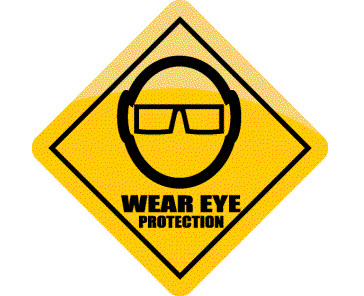How many jobs in your facility could be performed by someone wearing a blindfold? Even a relatively minor eye injury can send a worker home for the day, so it makes not only safety sense but also business sense to protect workers’ eyes.
 |
March is Workplace Eye Health and Safety Month, which makes this an appropriate time to talk about eye safety. The brief checklist below can help identify common eye hazards and select appropriate protection.
Identify Vision Hazards
- Are hazardous liquids that could spray or splash present in the workplace?
- Is flying debris generated in the workplace (for example, sawdust or metal shavings)?
- Are lasers used in the workplace?
- Does welding or grinding take place in the workplace?
- Could falling or flying object hazards occur in the workplace?
Implement Hazard Controls
- Are guards in place to control flying debris?
- Are restricted areas established to protect bystanders?Are workers trained in safe work practices that prevent spraying and splashing of hazardous liquids?
- Are workers trained in safe work practices that prevent creation of projectile hazards?
All the safety training you need in one program: 25 subjects, one low price. It’s BLR’s Safety Training Presentations. Try it at no cost. Get the details.
Select Eyewear
- Is protection from particulates and solid materials, such as that provided by safety glasses, required? If yes, are side shields required?
- Is protection from spraying and splashing liquids, such as that provided by chemical safety goggles or face shields, required?
- Do workers need protection from harmful light radiation, such as lasers or welding arcs?
- Do workers need safety eyewear that is compatible with other equipment, such as hearing protection, head protection, or respiratory protection?
Additional Considerations
- Is a safety eyewash provided in areas where spraying or splashing of hazardous liquids may occur?
- Do workers know how to properly clean and store their protective eyewear?
- Do workers have access to prescription lenses for vision correction as needed?
- Do workers know how to obtain replacements for damaged safety eyewear?
Try Safety Training Presentations at no cost and no risk. Find out more.
Protect Workers with Training
If you’ve been looking for quality training or training on a wide range of safety topics, including PPE and injury prevention, look no farther. Safety Training Presentation gets you off to a good start with 25 core PowerPoint® safety presentations, each one responsive to either an OSHA training requirement or to common causes of workplace accidents. All are customizable, so you can add your specific hazards or safety policies.
Each lesson also includes completion certificates, sign-in sheets, evaluation forms, and training records. In short, it contains everything you need to motivate, reinforce, retain, and transfer new knowledge—and document that you did so.
Safety Training Presentation topics covered include:
—Bloodborne Pathogens
—Back Safety
—Emergency Action
—Ergonomics
—Fire Prevention
—PPE
—Welding/Cutting/Brazing
—Portable Power Tool Safety
—Scaffolds
—Lockout/Tagout
—Forklift Operator Safety
—Confined Space Safety
—Fall Protection
—Respiratory Protection
—and more!
Of course, training needs change as OSHA introduces new requirements or as new work practices and technologies bring new hazards. To cover this, you receive a new CD every 90 days you’re in the program, each containing five additional or updated topics.
Just as important for those on a budget (and who isn’t these days?), the cost of these presentations works out to under $20 each.
We’ve arranged for Advisor subscribers to get a no-cost, no-obligation look at Safety Training Presentations for 30 days. Feel free to try a few lessons with your own trainees. Please let us know, and we’ll be glad to set it up.
